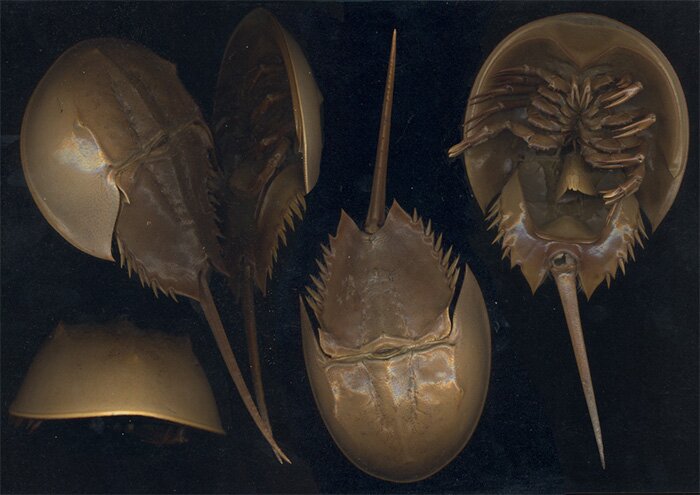International Horseshoe Crab Day | 20 Jun 2020
Why in News
Recently, the International Union for Conservation of Nature (IUCN)’s has decided to observe the first-ever International Horseshoe Crab Day on 20th June 2020.
- The celebration of the day aims to generate greater awareness for these ancient creatures and help in their conservation.
Key Points
- Horseshoe Crab:

- It is a marine chelicerate arthropod living in shallow coastal waters on soft sandy or muddy bottom and spawns (release or deposit eggs) mostly on intertidal beaches at summer spring high tides.
- Subphylum Chelicerata is a division within the Phylum Arthropoda containing animals such as spiders, scorpions, harvestmen, mites and ticks. Like all arthropods, they have a segmented body and segmented limbs and a thick chitinous cuticle called an exoskeleton.
- Other than the marine horseshoe crabs, the Chelicerata are found primarily in terrestrial environments worldwide.
- It is regarded as a marine ‘living fossil’.
- There are four extant horseshoe crab species:
- The American horseshoe crab (Limulus polyphemus) along the eastern coast of the USA and in the Gulf of Mexico.
- The tri-spine horseshoe crab (Tachypleus tridentatus)
- The coastal horseshoe crab (Tachypleus gigas)
- The mangrove horseshoe crab (Carcinoscorpius rotundicauda)
- The last three are Indo-pacific species found in the coastal waters of India, southeast Asia, China and Japan.
- Odisha is their largest habitat in India.
- It is a marine chelicerate arthropod living in shallow coastal waters on soft sandy or muddy bottom and spawns (release or deposit eggs) mostly on intertidal beaches at summer spring high tides.
- Importance:
- They have existed since the time of the dinosaurs and are important ecosystem engineers and predators of small organisms.
- Their ecological function is to lay millions of eggs on beaches to feed shorebirds, fish and other wildlife.
- Their large hard shell serves as a microhabitat for many other species such as sponges, mud crabs, mussels and snails.
- They are a critical link to world health, biodiversity and hold cultural importance across the globe.
- Threats:
- Overharvesting for use as food, bait and biomedical testing.
- Habitat Destruction:
- Habitat loss from coastal reclamation and development.
- Shoreline alterations that are engineered to protect beaches from erosion and sea level rise due to climate change also affect their spawning habitats.
- Poachers kill them for their meat which is popularly believed to have aphrodisiac qualities.
- Trade in horseshoe crabs is rampant in many Indian states as it is believed that consumption of horseshoe crab meat can lengthen a person’s lifespan, even though there is no scientific evidence to support this.
- Its carapace (hard upper shell) is crushed and mixed with water to prepare a paste, which is applied onto scars.
- Conservation:
- It is in the Schedule IV of the Wildlife Protection Act 1972, under which the catching and killing of a horseshoe crab is an offence.
- IUCN Status:
- American horseshoe crab: Vulnerable.
- Tri-spine horseshoe crab: Endangered.
- The two other species are not listed yet.
- The crackdown on horseshoe crab poachers requires superior, inter-state coordination among police and wildlife authorities of Odisha, Bihar, Jharkhand and other states.
- The Zoological Survey of India has suggested declaring the habitat of horseshoe crabs as Eco-Sensitive Zones for their conservation and proper management.
